- Table of contents
- 2.2 Automatic Picture Transmission
2.2 Automatic Picture Transmission¶
APT means Automatic Picture Transmission. It is a system, developed in the 1960s, made to transmit low-resolution analog image for weather satellites. A complete APT image takes around 12 minutes to be built up at a rate of 2 lines per second. The data is broadcasted by the satellite. The stream is obtained by the AVHRR/3 instrument. Two channels with a low resolution are emitting all the time using VHF signals at reduced rates (around 120 lines/minutes).The two channels are composed of :
- Channel A: A visible frequency range channel providing APT imagery during the day.
- Channel B: An IR channel providing APT imagery at any time of the day and the night.
2.2.1 Technical characteristics of APT¶
The frequencies range is 137-138 MHz (audible frequencies)and specificially 137.100 MHz for NOAA 19, 137.9125 MHz for NOAA 18, 137.620 MHz for NOAA 15. The overall RF bandwidth is equal to 34 kHz. The modulation mode is NFM (NarrowBand Frequency Modulation) and a 2.4 kHz AM (Amplitude Modulation) subcarrier is modulated on FM carrier. A circularly polarized antenna is usually needed (RHCP) but other types have also been used. The data resolution is 4 km/pixel at a line rate of 120 lines/minute or 2 lines/second anad the transmitted power : 5W (37 dBm).
2.2.2 APT Frame format¶
The broadcasted transmission is made of two channels for the image, synchronization and telemetry information. A complete APT Video Line Time is 2080 pixels long (990 pixels for each image). One APT line is composed of one line for Channel A video followed by one line for Channel B video.
- Telemetry frame:
Each video channel A and B have their own telemetry frame
Each telemetry frames consists of 16 points (wedges): height of 128 video lines
Telemetry frame rate is 1 frame per 64 seconds
Each telemetry point is repeated on 8 successive APT lines - Space and minute marker:
Time between two successive markers is one minute
Minute markers are repeated on 4 successive lines, with 2 lines black and 2 lines white
B video is always an IR channel (Ch. 4 usually), so spaces are white and minute markers black
When A Video is a visible channel, spaces are black and minute markers white; otherwise it appears like B video

Figure 2.1 APT Frame
- APT Synchronization:
Sync A precedes Channel A data. Is a 1040 Hz square wave - 7 cycles
Sync B precedes Channel B data. Is an 832 pps pulse train - 7 pulses

Figure 2.2 APT Synchronization
More information about the APT video format are seen below in Figure 2.3.

Figure 2.3 APT Video Format
In following years, digital signals produced by Low Rate Picture Transmission (LRPT) systems will replace APT.
